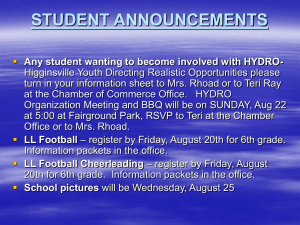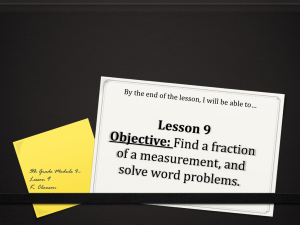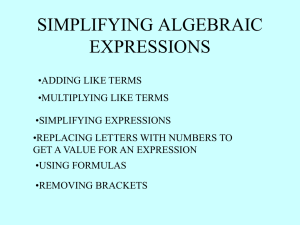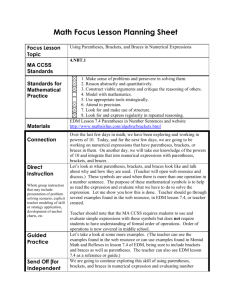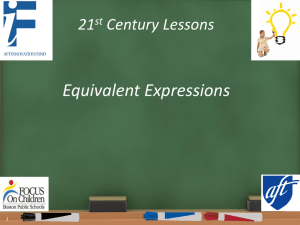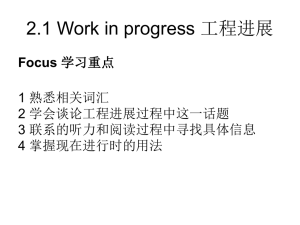Lesson 10 Objective: Compare and evaluate
advertisement
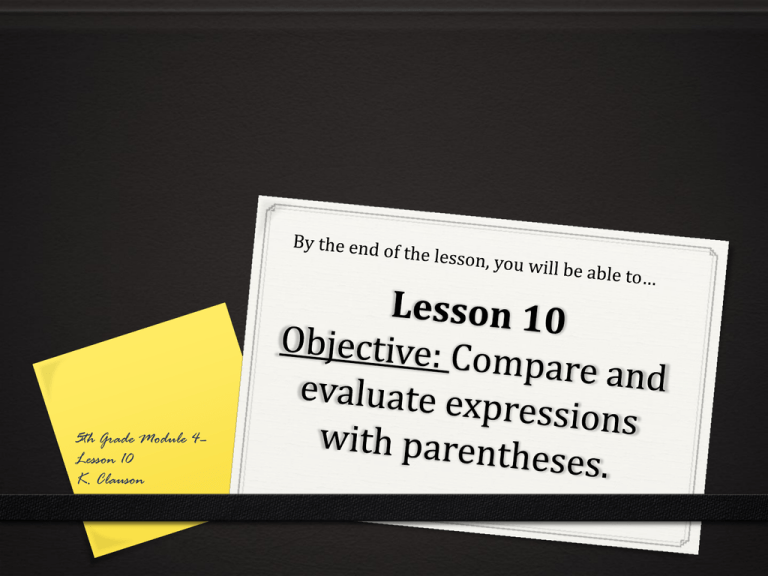
5th Grade Module 4– Lesson 10 K. Clauson Convert Measures from Small to Large Units 122inc = = _______ _______ pt ft 24 in = _______ ft 36 in = _______ ft 48 in = _______ ft 120 in = _______ ft Howmany manypints feet are are in in 2 12cups? inches? How 4 c = _______ pt 6 c = _______ pt 16 c = _______ pt Multiply a fraction and a whole number Find the Unit Conversion Application Problem Bridget has $240. She spent 3/5 of her money and saved the rest. How much more money did she spend than save? Problem 1: Write an expression to match a tape diagram. Then, evaluate. Read the expression that names the whole. What do we call the answer to an addition sentence? So, this tape diagram is showing 3 fourths of the sum of 9 and 11. Work with a partner to write a numerical expression to match these words. How many units is the sum being divided into? What is the name of that fractional unit? How many fourths are we trying to find? Problem 1: Write an expression to match a tape diagram. Then, evaluate. 3 fourths the sum of 9 and 11 (9 + 11) × ¾. The parentheses tell us to add 9that and 11 first, and I noticed multiply. manythen of you put If the parentheses weren’t parentheses there, around 9 +we 11.would have to multiply Explain to a first. We want to find the neighbor whysum first, and multiply. that then is necessary. ¾ × (9 + 11) 9 + 11 X 3 4 What is the final answer? Problem 1: Write an expression to match a tape diagram. Then, evaluate. Problem 1: Write an expression to match a tape diagram. Then, evaluate. Look at this model. How is it different from the previous example? This time, we don’t know the whole. In this diagram, the whole is being divided into fifths, not fourths. Here, we know what 1 fifth is. We know it is the difference of 1/3 and 1/4. We have to multiply the difference of 1/3 and 1/4 by 5 to find the whole. Problem 1: Write an expression to match a tape diagram. Then, evaluate. Read the subtraction expression that tells the value of one unit (or 1 fifth) in the model. What is the name for the answer to a subtraction problem? This unit is the difference of one-third and one-fourth. Work with a partner to write a numerical expression to match these words. How many of these (1/3−1/4) units does our model show? 5 units of 1/3−1/4 Problem 1: Write an expression to match a tape diagram. Then, evaluate. 5 ×(1/3−1/4) or (1/3−1/4) × 5. Do we need parentheses for this expression? What is the final answer? Problem 1: Write an expression to match a tape diagram. Then, evaluate. Problem 2: Write and evaluate an expression from word form. the product of 4 and 2, divided by 3 Let’s read this expression! Work with a partner to write a matching numerical expression. Were the parentheses necessary here? Why or why not? (4 × 2) ÷ 3 4×2 3 4×2÷3 Problem 2: Write and evaluate an expression from word form. the product of 4 and 2, divided by 3 (4 × 2) ÷ 3 4×2 3 4×2÷3 Work independently to evaluate your expression. Express your answer as both a fraction greater than one (improper fraction) and a mixed number. Check your work with a neighbor when you’re finished. Problem 3: Evaluate and compare equivalent expressions. a. 2 ÷ 3 × 4 b. 4 thirds doubled c. 2 ÷ (3 × 4) d. 2/3 × 4 e. 4 copies of the sum of one-third and one-third f. (2 ÷ 3) × 4 Evaluate these expressions with your partner. Continue working until I call time. Be prepared to share. Problem 3: Evaluate and compare equivalent expressions. What do you notice? The answer is 8 thirds every time, except (c). All of the expressions are equivalent, except (c). These are just different ways of expressing 8/3. a. 2 ÷ 3 × 4 b. 4 thirds doubled c. 2 ÷ (3 × 4) d. 2/3 × 4 e. 4 copies of the sum of What was different about (c)? one-third and one-third f. (2 ÷ 3) × 4 Since the expression had parentheses, we had to multiply first, and then divide. It was equal to 2 twelfths. Problem 5: Compare expressions in word and numerical forms. Let’s use <, >, or = to compare expressions. a. 𝟏/𝟖 the sum of 6 and 14 b. 4 × 𝟖/𝟑 (6 + 14) ÷ 8 4 times the quotient of 3 and 8 c. Subtract 2 from 𝟏/𝟐 of 9 (11 ÷ 2) – 2 Answers are on the next slide….. Problem 5: Compare expressions in word and numerical forms. Let’s use <, >, or = to compare expressions. a. 𝟏/𝟖 the sum of 6 and 14 b. 4 × 𝟖/𝟑 > = (6 + 14) ÷ 8 4 times the quotient of 3 and 8 c. Subtract 2 from 𝟏/𝟐 of 9 < (11 ÷ 2) – 2 Get Ready to Finish the Problem Set on Your Own! Complete Lesson 10. You will have 10 minutes to work. Try your Best! 5th Grade Module 4– Lesson 10 K. Clauson • Take 2 minutes to check your answers with your partner. • Let’s share any insights you had while solving these problems. 5th Grade Module 4- Lesson 10 K. Clauson EXIT TICKET LESSON 10 5th Grade Module 4– Lesson 10 K. Clauson
